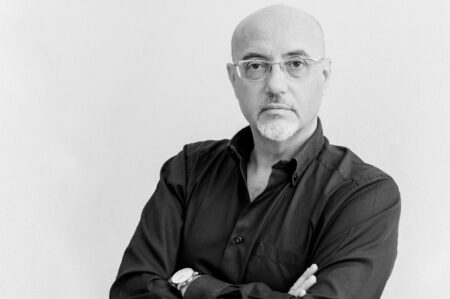Giuseppe Bavuso designer by ERCO for 10 years

On the occasion of the 10-year collaboration with Erco, the architect and designer Giuseppe Bavuso retraces his design process with the Como-based company, the first and only reality in the world of doors and windows to make use of an art director for the design of windows and doors since 2011. design. He was entrusted with the task of transforming the window into an innovative project in terms of aesthetics and functionality, elevating it to a functional and aesthetically customizable design element.
Giuseppe Bavuso talked to us about the innovative window systems made with Erco, the Shade and Dry collections, and about what will be the evolution of the window frame for the future, but also about sustainability and energy saving and his personal way of interpreting the architecture and design, considered two souls of the same discipline.
You have been collaborating with Erco for 10 years as Art Director: no door or window company, even bigger and more important, has a collaboration of this level, what does it mean for you to have created a "design window"? Could you tell us about the path and the experience gained over the years in the field of doors and windows?How did the inspiration for the design of Shade come about?
“In recent years, we have worked as if the window were split into two separate elements: the internal part and the external part. Having taken note of all the technical and performance characteristics that the object had to have, we concentrated on creating a dress more suited to the current design, working on the frame so that it could be aesthetically beautiful as well as highly performing. Our goal, starting from assumptions that are very technical, linked to the performance and functions that the window must have, is to be able to interpret it with my way of seeing design and architecture. In fact, design and architecture are two souls of the same discipline "
And then came the Dry collection: what was the “vision” and what did winning the Red Dot Award mean?
"Then Dry was also born, with which the company won the Red Dot Award in 2019. This was a beautiful achievement because it gratified our team work: we worked to create a beautiful window, certainly not to win the prize. But this means that we have not only achieved the commercial production objectives that the company set itself, but also to have created a beautiful product recognized also in a general sense for all its aesthetic and performance characteristics, by the world of design and by those who judge. and values what we do ".Powered by Froala Editor
Powered by Froala Editor

In occasione dei 10 anni di collaborazione con Erco, l’architetto e designer Giuseppe Bavuso ripercorre il suo iter progettuale con l’azienda comasca, prima e unica realtà nel mondo del serramento ad avvalersi dal 2011 di un art director per la progettazione di infissi di design. A lui è stato affidato il compito di trasformare la finestra in un progetto innovativo per estetica e funzionalità, elevandola a un elemento di design funzionale e personalizzabile. Giuseppe Bavuso ci ha parlato degli innovativi sistemi di infissi realizzati con Erco, le collezioni Shade e Dry, e di quella che sarà l’evoluzione del serramento per il futuro, ma anche di sostenibilità e risparmio energetico e del suo modo personale di interpretare l’architettura e il design, considerate due anime della stessa disciplina.
Sono 10 anni che collabora con Erco in qualità di Art Director: nessuna azienda di serramenti, anche più grande e importante, ha una collaborazione di questo livello, cosa significa per lei aver realizzato un “serramento di design”? Ci può raccontare il percorso e l’esperienza maturata in questi anni nel campo dei serramenti?
“Mi è piaciuto fin da subito cogliere la sfida che Erco mi aveva proposto, e cioè quella di lavorare in un settore, quello della serramentistica, che per me era nuovo e in generale per il mondo del design non era consueto. La sfida è stata proprio quella di prendere un elemento architettonico quasi sempre secondario, e non molto caratterizzato nella sua struttura, per farlo diventare un vero e proprio oggetto di design, e nello stesso tempo estremamente importante nella definizione architettonica dell'edificio, lavorando in due direzioni complementari: l'aspetto tecnico e prestazionale nella direzione della sostenibilità e sull’aspetto estetico che è sempre stato trascurato”.
Come è arrivata l’ispirazione per la progettazione di Shade?
“In questi anni, abbiamo lavorato come se il serramento fosse sdoppiato in due elementi separati: la parte interna e la parte esterna. Preso atto di tutte le caratteristiche tecniche e prestazionali che l’oggetto doveva avere, ci siamo concentrati per realizzare un abito più consono all’attualità del design, lavorando sull’infisso in modo che potesse essere, oltre che fortemente prestazionale, anche bello esteticamente. Il nostro obiettivo, partendo da dei presupposti che sono molto tecnici, legati alle prestazioni e funzioni che il serramento deve avere, è quello di poterlo poi interpretare con il mio modo di vedere il design e l’architettura. Design e architettura sono infatti due anime della stessa disciplina”
E dopo è arrivata la collezione Dry: qual è stata la “visione” e cosa ha significato vincere il Red Dot Award?
“Successivamente è nato anche Dry, con cui l’azienda si è aggiudicata il Red Dot Award nel 2019. Questo è stato un bellissimo traguardo perché ha gratificato il nostro lavoro di squadra: abbiamo lavorato per realizzare un bel serramento, non certo per vincere il premio. Ma ciò significa che abbiamo centrato non solo gli obiettivi di produzione commerciale che l’azienda si poneva, ma anche di aver ideato un bel prodotto riconosciuto anche in senso generale per tutte le sue caratteristiche estetiche e prestazionali, dal mondo del design e da chi giudica e valorizza quel che noi facciamo”.
